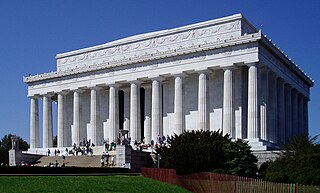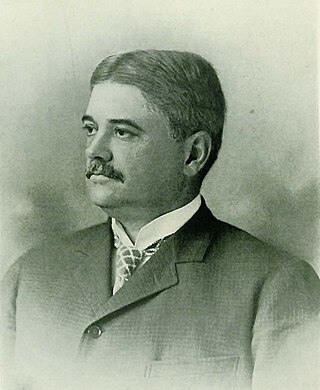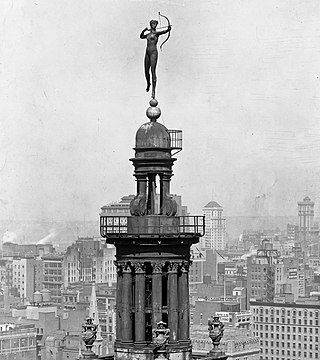
Henry Bacon was an American Beaux-Arts architect who oversaw the engineering and design of the Lincoln Memorial in Washington, D.C., built between 1915 and 1922, which was his final project before his 1924 death.

Augustus Saint-Gaudens was an Irish and American sculptor of the Beaux-Arts generation who embodied the ideals of the American Renaissance. Saint-Gaudens was born in Dublin to an Irish-French family, and raised in New York City. He traveled to Europe for further training and artistic study. After he returned to New York City, he achieved major critical success for his monuments commemorating heroes of the American Civil War, many of which still stand. Saint-Gaudens created works such as the Robert Gould Shaw Memorial on Boston Common, Abraham Lincoln: The Man, and grand equestrian monuments to Civil War generals: General John Logan Memorial in Chicago's Grant Park and William Tecumseh Sherman at the corner of New York's Central Park. In addition, he created the popular historicist representation of The Puritan.

Allen George Newman III was an American sculptor, best known for his statue "The Hiker".

Giuseppe Moretti was an Italian émigré sculptor who became known in the United States for his public monuments in bronze and marble. Notable among his works is Vulcan in Birmingham, Alabama, which is the largest cast iron statue in the world. On a personal level, Moretti was "known for his eclectic personality and for always wearing a green tie," but professionally, is claimed to be "the first man to use aluminum in art." Moretti enjoyed some celebrity in his lifetime, and was a friend of famed Italian tenor Enrico Caruso. It is even reported that the singer repeatedly praised Moretti's voice.

The Adams Memorial is a grave marker for Marian Hooper Adams and Henry Adams located in Section E of Rock Creek Cemetery, Washington, D.C. The memorial features a cast bronze allegorical sculpture by Augustus Saint-Gaudens. Saint-Gaudens' shrouded-figure statue is seated against a granite block which takes up one side of a hexagonal plaza, designed by architect Stanford White. Across from the statue is a stone bench for visitors. The whole is sheltered by a close screen of dense conifers.

Schenley Plaza is a public park serving as the grand entrance into Schenley Park in Pittsburgh, Pennsylvania.

The Mary Schenley Memorial Fountain, also known as A Song to Nature, is a 1918 landmark public sculpture in bronze and granite by Victor David Brenner. It sits in Schenley Plaza at the entrance to Schenley Park and directly in front of the University of Pittsburgh's Frick Fine Arts Building in Pittsburgh, Pennsylvania, United States. The fountain is designated as a contributing property to the Schenley Farms Historic District.

Christopher Lyman Magee was a powerful political boss in Pittsburgh, Pennsylvania, United States. Along with William Flinn (1851–1924), his political partner, the two ran the Republican Party machine that controlled the city for the last twenty years of the 19th century. He was also a leading philanthropist and hospital patron.

Abraham Lincoln: The Man is a larger-than-life size 12-foot (3.7 m) bronze statue of Abraham Lincoln, the 16th president of the United States. The original statue is in Lincoln Park in Chicago, and later re-castings of the statue have been given as diplomatic gifts from the United States to the United Kingdom, and to Mexico.

Frank Vittor was an American sculptor, known for his "preference for the heroic and colossal".

The Puritan is a bronze statue by sculptor Augustus Saint-Gaudens in Springfield, Massachusetts, which became so popular that it was reproduced for over 20 other cities, museums, universities, and private collectors around the world, and later became an official symbol of the city, emblazoned on its municipal flag. Originally designed to be part of Stearns Square, since 1899 the statue has stood at the corner of Chestnut and State Street next to The Quadrangle.

Diana – also known as Diana of the Tower – is an iconic statue by sculptor Augustus Saint-Gaudens, representing the goddess Diana. Once a major artistic feature of New York City, the second version stood atop the tower of Madison Square Garden from 1893 to 1925. Since 1932, it has been in the collection of the Philadelphia Museum of Art.

The James A. Garfield Monument is a monument honoring the 20th president of the United States in Philadelphia, Pennsylvania, United States. Sculptor Augustus Saint-Gaudens and architect Stanford White collaborated on the memorial, which was completed in 1896. It is located in Fairmount Park, along Kelly Drive, near the Girard Avenue Bridge.

William Tecumseh Sherman, also known as the Sherman Memorial or Sherman Monument, is a sculpture group honoring William Tecumseh Sherman, created by Augustus Saint-Gaudens and located at Grand Army Plaza in Manhattan, New York. Cast in 1902 and dedicated on May 30, 1903, the gilded-bronze monument consists of an equestrian statue of Sherman and an accompanying statue, Victory, an allegorical female figure of the Greek goddess Nike. The statues are set on a Stony Creek granite pedestal designed by the architect Charles Follen McKim.

Admiral David Glasgow Farragut, also known as the Admiral Farragut Monument, is an outdoor bronze statue of David Farragut by Augustus Saint-Gaudens on a stone sculptural exedra designed by the architect Stanford White, installed in Manhattan's Madison Square, in the U.S. state of New York.

The Westinghouse Memorial is a bronze monument located in the U.S. city of Pittsburgh, Pennsylvania. It commemorates George Westinghouse, an engineer, founder of the Westinghouse Electric Corporation, and inventor of the railway air brake. The memorial is located at the entrance to the Steven Faloon trail, a part of Schenley Park. The architects for the monument and the surrounding area were Henry Hornbostel and Eric Fisher Wood. Daniel Chester French was the sculptor for the statue and the main panel, and Paul Fjelde designed the side panels.

The Henry W. Maxwell Memorial is a public memorial located in Brooklyn's Grand Army Plaza in New York City. The memorial, designed by sculptor Augustus Saint-Gaudens, consists of a bronze tablet featuring a relief of Maxwell, a local philanthropist and park commissioner, affixed to a boulder. The memorial was dedicated in 1903 at the intersection of Eastern Parkway and Flatbush Avenue. In 1912, the memorial was moved to its present location at Grand Army Plaza. In the 1970s, due to vandalism, the plaque was removed and placed in storage, with a replacement plaque affixed to the boulder in 1996. The original plaque is located in the Brooklyn Museum.

The Colonel James Anderson Monument is a public monument in Pittsburgh, Pennsylvania, United States. It was designed by Daniel Chester French and commissioned by businessman and philanthropist Andrew Carnegie. Anderson had opened his personal book collection to the youth of Allegheny, Pennsylvania, including Carnegie, and his actions would later inspire Carnegie to create the Carnegie library system. The monument, dedicated in 1904, is located outside the Carnegie Free Library of Allegheny.

A statue of Christopher Columbus is installed in Pittsburgh's Schenley Park, in the U.S. state of Pennsylvania.

Signing of the Mayflower Compact (1922) is a fifteen-figure, bas-relief sculpture by Cyrus E. Dallin located at the base of Monument Hill below the Pilgrim Monument in Provincetown, Massachusetts. The sculpture is one of three major commissions he received as part of the Pilgrim Tercentenary in 1920. The other two were the statue of Massasoit in Plymouth, Massachusetts and the Pilgrim half dollar, which featured renditions of a pilgrim and the Mayflower under sail.






















